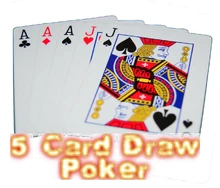This article about a poker variant is a stub. Help PokerWiki out by adding to it.

Five-card draw poker used to be the most prominent variant non-players thought about poker. (Since the poker boom, its visibility has largely been obscured by hold'em.
Mechanics[]
In casino play the first betting round begins with the player to the left of the big blind, and subsequent rounds begin with the player to the dealer's left. Home games typically use an ante; the first betting round begins with the player to the dealer's left, and the second round begins with the player who opened the first round. Play begins with each player being dealt five cards, one at a time, all face down. The remaining deck is placed aside, often protected by placing a chip or other marker on it. Players pick up the cards and hold them in their hands, being careful to keep them concealed from the other players, then a round of betting occurs.
If more than one player remains after the first round, the "draw" phase begins. Each player specifies how many of their cards they wish to replace and discards them. The deck is retrieved, and each player is dealt in turn from the deck the same number of cards they discarded so that each player again has five cards.
A second "after the draw" betting round occurs beginning with the player to the dealer's left or else beginning with the player who opened the first round (the latter is common when antes are used instead of blinds). This is followed by a showdown, if more than one player remains, in which the player with the best hand wins the pot.
Jacks-or-better[]
Until California legalized "stud" games, including hold'em, in 1987, draw was the most popular game in cardrooms there. Specifically, the prominent variant was "jacks-or-better" where a player was required to have at least a pair of jacks to bet before the draw.
Contemporary online draw[]
Strategy and tactics[]
If a player has three of a kind and several other players have drawn new cards, one strategy is to draw only one card. Other players may underestimate the hand, believing the player has two pairs or lacks a card for a straight or flush. In games with a full card deck and four or more players, two pairs can often be the winning hand.
It's also imperative to vary both the way to draw the numbers of new cards in equal situations and how to bet both before and after the draw. If a player is "easy to read" he very seldom will win large pots even when holding a very good hand.
The most common error is to "throw good money after bad" and make high-stakes calls because he or she thinks the other player is bluffing. Very few true bluffs really work in the long run; the bluffer usually has some kind of strength to his or her hand, but plays the hand as if it were higher than it really is. For instance, a player may bluff by playing a pair of aces as if it were a straight, flush, or full house. Such a play is "insured" against all lower pairs, but far too often player with a lower pair calls at expensive times only to make sure he or she is not bluffed. On the other hand, cheap calls are usually not considered to be throwing good money away, especially when calling an unknown player. Seeing the player's hand may be worth the small amount of money in the long run.
A player may benefit in the long run if he or she is discovered to be bluffing. A player may intentionally declare to be pleased with a bad hand and bet low for the sole purpose of being discovered. This may benefit the player later if he has a good hand and wants keep other players from folding. The downside of this strategy is that a bluffer may have to wait a long time before he or she can successfully trap other players with this strategy.
- Pre-draw odds of getting each hand
- Royal flush <0.01%
- Straight flush (not including royal flush) <0.01%
- Four of a kind 0.02%
- Full house 0.14%
- Flush (excluding royal flush and straight flush) 0.20%
- Straight (excluding royal flush and straight flush) 0.39%
- Three of a kind 2.11%
- Two pair 4.75%
- One pair 42.30%
- No pair / High card 50.10%
Discussion threads[]
- Five Card Draw (2+2, November 2005) - Discusses the best available books on 5CD.
| Poker variants on PokerWiki |
|---|
| Limit hold 'em | No-limit hold 'em | Spread-limit hold 'em | Omaha high | Omaha hi-lo | Big O | 7-stud | 7-stud hi-lo |
| Razz | 5-stud | 5-draw | Lowball | Chinese Poker |